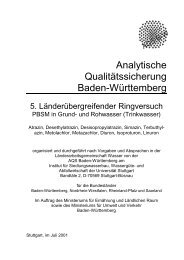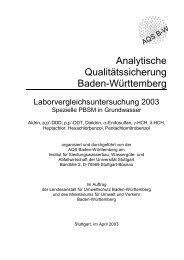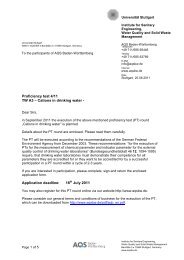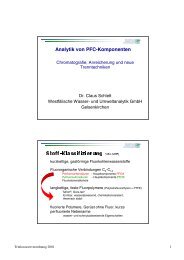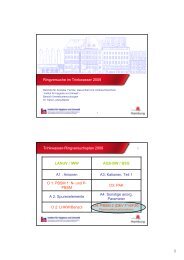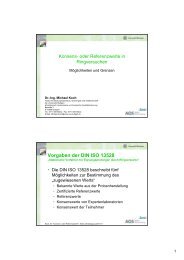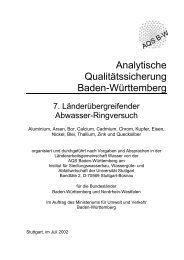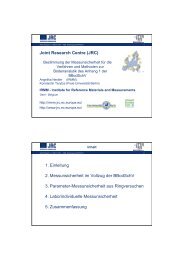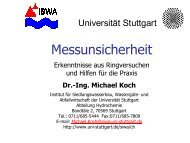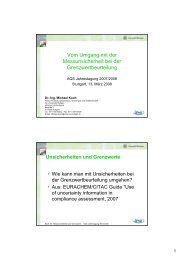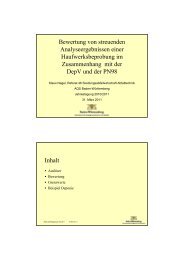Institute for Sanitary Engineering, Water Quality and Solid Waste ...
Institute for Sanitary Engineering, Water Quality and Solid Waste ...
Institute for Sanitary Engineering, Water Quality and Solid Waste ...
You also want an ePaper? Increase the reach of your titles
YUMPU automatically turns print PDFs into web optimized ePapers that Google loves.
Biological Air Purification ALR<br />
Projects<br />
System biology in Pseudomonas<br />
In this project, the production of low molecular organic<br />
compounds by bacteria is researched. There<strong>for</strong>e<br />
metabolic networks <strong>and</strong> genes are examined. Due to a<br />
confidentiality obligation, no further in<strong>for</strong>mation of this<br />
project could be shared.<br />
Financing institution:<br />
BMBF und BASF<br />
Duration:<br />
2009-2011<br />
Contact:<br />
Dr.-Ing. Niko Strunk<br />
M.Sc. Diego Salamanca<br />
Expertise <strong>and</strong> assignments<br />
Biodegradation of benzoate under hypersaline<br />
conditions<br />
Common bacteria normally used in the degradation<br />
of natural <strong>and</strong> xenobiotic compounds tolerate sodium<br />
chloride concentrations of up to 3.5 w%. This concentration<br />
is similar to saline concentrations in maritime<br />
habitates. Habitates with saline concentrations beyond<br />
3.5 w% like salterns, industrial solar salt refineries,<br />
brines out of the olive oil production or spezial industrial<br />
waste waters can only be populated by specialised<br />
bacteria <strong>and</strong> archaea. In most cases industrial waste<br />
waters as well as waste waters of the olive oil production<br />
include high COD freights. The biodegradability of<br />
benzoate as main compound in these industrial waste<br />
waters under technical aspects is the core aspect of<br />
this third-party funded project.<br />
In the Technical Instruction on Air <strong>Quality</strong> of the year<br />
2002 „TA-Luft 2002“ a limit value of 20 mg C/m³ is<br />
defined <strong>for</strong> the treated air of a hazardous waste recycling<br />
plant. However, the limit value during design <strong>and</strong><br />
construction of this plant was 100 mg C/m³. To fulfill<br />
the new limit values the existing system consisting of<br />
preconditioning <strong>and</strong> bioscrubber units was modernised<br />
<strong>and</strong> complemented in cooperation with the partner of<br />
the project. In analytical campaigns on-site as well as<br />
in semi-technical scale in the rooms of the <strong>Institute</strong><br />
the total waste air compounds were identified <strong>and</strong> carbon<br />
freight, related compound concentrations as well<br />
as specific degradation rates in both plants were measured.<br />
Since the summer of the year 2008 the industrial<br />
scale plant is capable to fulfill the limit values of<br />
the TA-Luft 2002.<br />
In a second phase of the project proceeding up to now<br />
the feasibility of additional waste water treatment is<br />
evaluated.<br />
Advisor: Dr.-Ing. D. Dobslaw<br />
Advisor: Dr.-Ing. D. Dobslaw<br />
Optimisation of an existing industrial scale biological<br />
waste air treatment system in a hazardous<br />
waste recycling company to fullfill limit values of<br />
the TA-Luft 2002<br />
Industrial plant <strong>for</strong> combined waste air <strong>and</strong> waste<br />
water treatment in a hazardous waste recycling company.<br />
The waste air (inlet on the right side) passes<br />
through an activated carbon filter (top right side) <strong>and</strong><br />
two serial connected bioscrubbers afterwards (top left<br />
side). In three tanks the circulation liquid (bottom left<br />
side) <strong>and</strong> the aqueous waste fractions (bottom right)<br />
are stored.<br />
109




